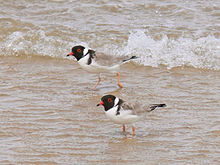Hooded plover
| Hooded plover | |
|---|---|

| |
| At Prosser River Spit, Orford, Tasmania, Australia | |
| Scientific classification | |
| Domain: | Eukaryota |
| Kingdom: | Animalia |
| Phylum: | Chordata |
| Class: | Aves |
| Order: | Charadriiformes |
| Family: | Charadriidae |
| Genus: | Charadrius |
| Species: | C. cucullatus
|
| Binomial name | |
| Charadrius cucullatus Vieillot, 1818
| |

| |
| Range | |
| Synonyms[2] | |
|
Charadrius rubricollis Gmelin, 1789 | |
The hooded plover or hooded dotterel (Charadrius cucullatus) is a species of bird in the family
Taxonomy
The hooded plover was
Description

The hooded plover is medium in size for a plover, stocky, and pale in colour. Its length is 190 to 230 mm (7.5–9.1 in) and its wing-span 230 to 440 mm (9.1–17.3 in). It has a black hood and throat with a white collar. Its red bill has a black tip. It has a red eye ring and orange legs.[11] Underparts are white. Males and females are similar. Adults and juveniles are similar except the juveniles do not have the black head and hindneck, which are instead a sandy brown.[12]
Distribution and habitat
Its natural
Behaviour

Breeding
A
Food and feeding
The eastern population eats a variety of
Threats
The population of hooded dotterels has declined in eastern Australia as a result of disturbance by people, dogs, cats and horses, as well as predation by silver gulls (Larus novaehollandiae), ravens (Corvus spp) and introduced foxes.[13][14] Fox predation is a major threat to the western subspecies. In 2000 the number of mature individuals was estimated at 7,000.[13]
Conservation
| AUS | NSW | VIC | TAS | SA | WA | |
|---|---|---|---|---|---|---|
| Charadrius cucullatus | Vulnerable[17] | Critically endangered[18] | Vulnerable[19] | Conservation Concern[20] | Vulnerable |
Important Bird Areas
BirdLife International has identified the following sites as being important for hooded dotterel conservation:[21]
|
|
|
See also
References
- ^ BirdLife International (2012). "Thinornis rubricollis". IUCN Red List of Threatened Species. 2012. Retrieved 26 November 2013.
- ^ "Thinornis cucullatus". Avibase.
- .
- ^ Peters, James Lee, ed. (1934). Check-List of Birds of the World. Vol. 2. Cambridge, Massachusetts: Harvard University Press. p. 247.
- ISBN 978-84-87334-20-7.
- ^ Olson, Storrs L. (1998). "Lectotypification of Charadrius rubricollis Gmelin, 1789". British Ornithologists' Club. 118 (4): 256–259.
- ^ ISBN 978-0-9568611-0-8.
- PMID 25916188.
- PMID 36038056.
- ^ Gill, Frank; Donsker, David; Rasmussen, Pamela, eds. (December 2023). "Buttonquail, thick-knees, sheathbills, plovers, oystercatchers, stilts, painted-snipes, jacanas, Plains-wanderer, seedsnipes". IOC World Bird List Version 14.1. International Ornithologists' Union. Retrieved 30 December 2023.
- ^ "Hooded Dotterel". Biodiversity Information Explorer. Retrieved 4 June 2011.
- ^ a b "Hooded Plover". Birds in Backyards. Retrieved 4 June 2011.
- ^ a b c d "Hooded Plover Thinornis rubricollis". BirdLife International. Retrieved 4 June 2011.
- ^ a b c "Thinornis rubricollis". IUCN Red List. IUCN. Retrieved 4 June 2011.[permanent dead link]
- ^ ISBN 0-646-42798-9.
- S2CID 245348998.
- ^ Environment, jurisdiction=Commonwealth of Australia; corporateName=Department of the. "Thinornis cucullatus cucullatus — Hooded Plover (eastern), Eastern Hooded Plover". www.environment.gov.au. Retrieved 2020-06-25.
{{cite web}}: CS1 maint: multiple names: authors list (link) - ^ "Hooded Plover - profile | NSW Environment, Energy and Science". www.environment.nsw.gov.au. Retrieved 2020-06-25.
- ^ "Hooded Plover". www.swifft.net.au. Retrieved 2020-06-25.
- ^ Bryant, Sally (2002). "Conservation assessment of beach nesting and migratory shorebirds in Tasmania" (PDF). Retrieved 2020-06-25.
- ^ "Hooded Plover". Important Bird Areas. BirdLife International. 2012. Retrieved 2012-10-27.
External links
 Data related to Thinornis rubricollis at Wikispecies
Data related to Thinornis rubricollis at Wikispecies- Hooded plover threats and recovery strategies

